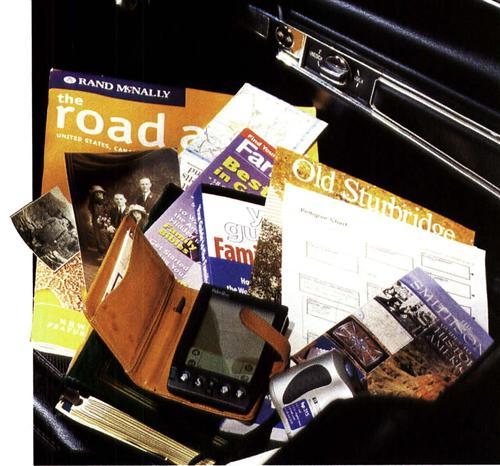Sign up for the Family Tree Newsletter Plus, you’ll receive our 10 Essential Genealogy Research Forms PDF as a special thank you!
Get Your Free Genealogy Forms
"*" indicates required fields
 One of the many positive side effects of last fall’s tragic events, surely unanticipated by the perpetrators, has been a surge in interest in exploring America’s historic sites.
One of the many positive side effects of last fall’s tragic events, surely unanticipated by the perpetrators, has been a surge in interest in exploring America’s historic sites.
Along with a national outpouring of patriotism came a renewed appreciation for the struggles and challenges, the setbacks and triumphs that make up the American saga. It’s not just an interest in the “great men” who led our history, but in the ordinary Americans who fought the battles and settled the frontier. Just look at television: The soldiers of HBO’s smash hit “Band of Brothers,” after all, were our parents and grandparents (or husbands or brothers — or us). The homesteaders whose tribulations are re-created in “Frontier House,” a new reality show airing on PBS on April 29, were our ancestors. (For more on that show and on tracing your frontier ancestors, see the June issue of our regular Family Tree Magazine, on sale April 23.)
Though most of those people who made our history are gone, the places where they lived, worked, fought, dreamed and died remain — often painstakingly restored and even populated by dedicated re-enactors. In the wake of Sept. 11, Americans have been seeking out those places in record numbers.
“Heritage and culture sites are now bigger than they have ever been,” Darienne Wilson, tourism director of the Mississippi Development Authority, told the New York Times in November. “People want to walk on the square of a small country town or an old battlefield. They want something calm in their life, and they want to go somewhere where they feel safe.”
Lamar Roberts, director of the storefront Gray and Blue Naval Museum in Vicksburg, Miss., added, “We get a lot of people who’ve just decided to slow down and stop in a lot of places they’ve never been, like right here. It’s a good time to be a history buff.”
Indeed it is, and that’s why the editors of Family Tree Magazine, America’s most popular family history publication, decided to produce this special guide to Heritage Travel. History and tourism have intertwined as never before, with Americans hitting the road to explore the places of our past, discover their family history and get together in family reunions, and even step back in time and re-enact history’s most fascinating events. If you want to join in the fun and adventure, this special issue is for you.
The centerpiece of this issue, of course, is our pullout calendar of hundreds of living history events and attractions from coast to coast (page 33). Here’s where you’ll find festivals celebrating your ethnic heritage, whatever that heritage happens to be — from Nisei Week in Los Angeles and the Portuguese Cabrillo Festival in San Diego to the Pella, Iowa, Tulip Time Festival for your Dutch roots and the Polish Heritage Festival in Holmdel, NJ. We’ll also guide you to museums covering every segment of our history, and to celebrations of all the diverse currents that came together to make America.
But that’s only the beginning. We’ll also take you to 10 of America’s most historic locales, places where the past is still present (page 8). This includes such classic destinations as Boston and Colonial Williamsburg, which celebrates its 75th anniversary as a re-enactment attraction this year, as well as lesser-known slices of yesterday such as Fort Robinson State Park in Nebraska and Los Caminos del Rio in Texas.
Or maybe you just want to spend a night in the past on your vacation trip to somewhere else. Consider the 25 historic places to stay in our guide to hotels and inns beginning on page 26. Looking for a place to stay that’s not necessarily historic but where your own extended family can all fit and celebrate your own history? We’ve picked 10 of the best resorts to hold your next family reunion (page 60).
If you’re seeking to learn more about that family history, a natural destination is Ellis Island, gateway for the immigrant ancestors of more than 40 percent of today’s US population. This landmark was recently reopened after a lengthy post-Sept. 11 closure. We tell you how to get the most out of a trip to Ellis Island beginning on page 20.
More and more vacationers are planning all or part of their entire trips around the quest for their ancestors. Before you hit the road in search of your family tree, check our expert tips on planning a family history vacation (page 68). And make sure to consult our regular Family Tree Magazine, with new issues every other month, plus our Web site <www.familytreemagazine.com>, for more on discovering, preserving and celebrating your family’s heritage.
For the ultimate historic vacation experience, of course, you can join the thousands of people who’ve discovered the fun of re-enactments. Whether you just want to watch or actually don authentic garb and try it yourself, you’ll find all you need to know beginning on page 50.
Whatever shape your heritage travel takes — a visit to Colonial Williamsburg, a festival celebrating your ethnic roots, a Civil War re-enactment — you’ll be doing more than just having a great vacation; you’ll be recapturing a piece of your past. I can’t think of anything more patriotic — or more fun.
From the May 2002 issue of Family Tree Magazine
ADVERTISEMENT

